Out of school care parent survey: report
Details the views of parents/carers of five to 13 year old children regarding out of school care, including term-time and holiday care.
3. Term-time childcare
Use of term-time childcare
- Overall, the majority of parents (58%) used some form of term-time childcare. It was more common for parents to use term-time care for younger children, aged 5 to 7 (62%) or 8 to 10 (64%), than older children aged 11 to 13 (48%).
- Working status was strongly associated with the use of term-time care, with families in which all parents were working more likely to use it than families with at least one non-working parent. As shown in Table 3.1, single parents working full-time were the family type most likely use term-time childcare (85%), while between 65% and 76% of other families in which all parents worked (either full-time or part-time) used childcare[12]. In comparison, only around a third (between 28% and 33%) of families with at least one-non working parent used childcare.
Table 3.1: Use of term-time care by working status
| Family working status | % use term-time childcare | Base |
|---|---|---|
| All parents working (full-time or part-time) |
72% |
1,594 |
| At least one parent not working |
30% |
408 |
| Single parent – working full-time |
85% |
144 |
| Single parent – working part-time |
65% |
108 |
| Single parent – not working |
30% |
98 |
| Couple – both working full-time |
76% |
671 |
| Couple – one parent working full-time, one working part-time; or both working part-time |
71% |
668 |
| Couple – one parent working full-time, one not working |
28% |
226 |
| Couple – neither working |
33% |
52 |
- Indeed, the main reason by far that parents gave for using term-time childcare was because it allows them to work, mentioned by 79% of all those who used term-time childcare (Figure 3.1). Meanwhile, much smaller proportions, said they used term-time childcare for reasons such as giving grandparents a chance to spend time with their child (6%), their child enjoying it (6%), or allowing the participant and/or their partner to study/train at college or university (4%).
Figure 3.1: Reasons for using term-time care
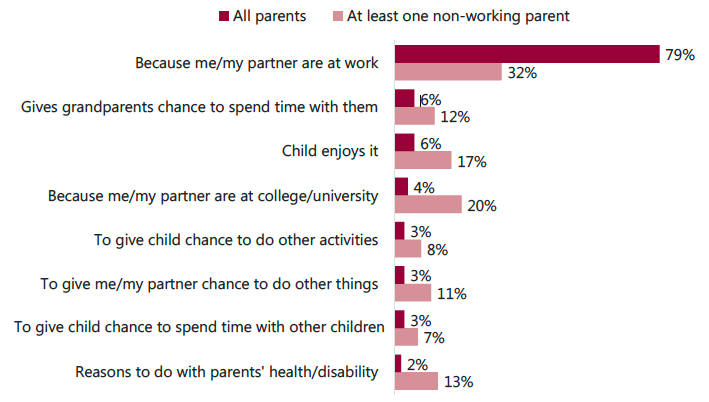
Base: All who use term-time childcare – all parents (1,253); at least one non-working parent (118) Participants could give more than one response
- Reasons for using term-time care differed somewhat for families with at least one non-working parent. While the most common reason was still that it allows the parents to work (32%), other reasons were more common – for example: it allows them or their partner to study/train at college or university (20%); their child enjoys it (17%); and for reasons related to the parents’ health/disability (13%).
Types of term-time childcare used
- Among those who used term-time childcare, just over half (56%) of parents only used informal care (e.g. grandparents, other family or friends), and 21% only used formal care (e.g. breakfast or after-school clubs). Around a quarter (23%) used both formal and informal types of care[13].
- As shown in Figure 3.2, grandparents were the most commonly used type of term-time childcare, used by 63% of parents who used any form of term-time care, while around a quarter used after-school clubs (23%) and breakfast clubs (22%).
Figure 3.2: Types of term-time care used (among those who used any care)
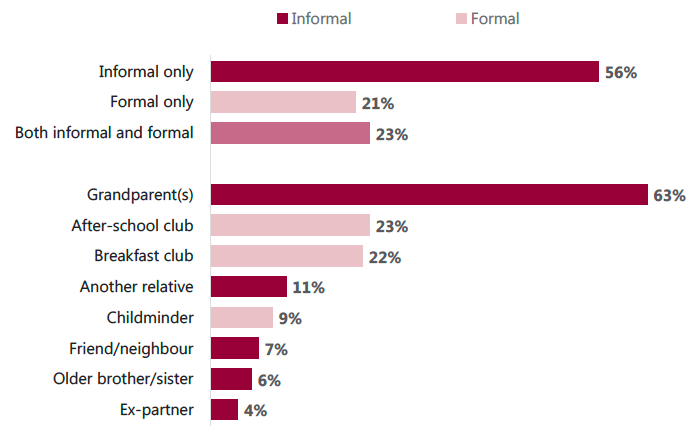
Base: All who use term-time childcare (1,253) Participants could give more than one response.
- As shown in Figure 3.3, older children, aged 11 to 13 were more likely than younger children to receive informal care only (71% of those who received any form of term-time childcare, compared with 48% of 5 to 7 year olds, and 54% of 8 to 10 year olds). Meanwhile, children aged 5 to 7 and 8 to 10 were more likely than older children to receive formal care only (23% and 24% respectively, compared with 14% of 11 to 13 year olds).
Figure 3.3: Types of term-time care used by age
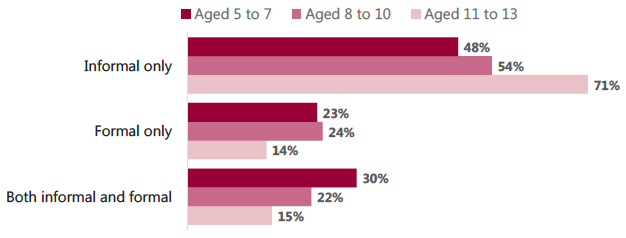
Base: All who use term-time childcare – parents of children aged 5 to 7 (456); 8 to 10 (461); 11 to 13 (336)
- The use of breakfast and after-school clubs was more popular for younger children, particularly those aged 5 to 7 – 28% of this age group (who received any term-time childcare) attended breakfast clubs, compared with23% of 8 to 10 year olds and 13% of 11 to 13 year olds; and 30% of 5 to 7 year olds attended after-school clubs, compared with 23% of those aged 8 to 10, and 16% of those aged 11 to 13.
- Families in living in the Lothians were more likely to use breakfast clubs (34%, compared with 22% overall) and after-school clubs (30%, compared with 23% overall).
- In terms of area deprivation, those in the most deprived areas (SIMD 1[14]) were more likely to use breakfast clubs[15] (31%, compared with 22% overall), while those living in the least deprived areas (SIMD 5) were more likely to use after-school clubs (36%, compared with 23% overall).
- Higher income families, earning more than £60,000 per annum, were more likely to use after-school clubs (34% of those, compared with 23% overall) and childminders (14%, compared with 9% overall). Parents living in the Highlands and Islands were also more likely to use childminders (16%, compared with 9% overall).
Views on breakfast and after-school clubs
Breakfast clubs
- Parents whose child attended a breakfast club (22% of those who used term-time care[16]) were very positive about the club, with almost all users saying it was both convenient and affordable.
- As shown in Figure 3.4, almost all (99%) parents who used a breakfast club agreed that its location was convenient, with 98% strongly agreeing. Almost all users also agreed that it was available on convenient days (96%) and at convenient times (94%). Most users also said that, given their family income, the breakfast club was affordable – 79% agreed, while 13% said this did not apply since they did not pay for the club. Only 4% of users disagreed with this statement. The fact that such small proportions disagreed with these statements on convenience and affordability suggests that these aspects are crucial in ensuring access to these services. (See Figure 3.6 below for reasons why other parents do not use breakfast or afterschool clubs.)
Figure 3.4: Views on breakfast clubs
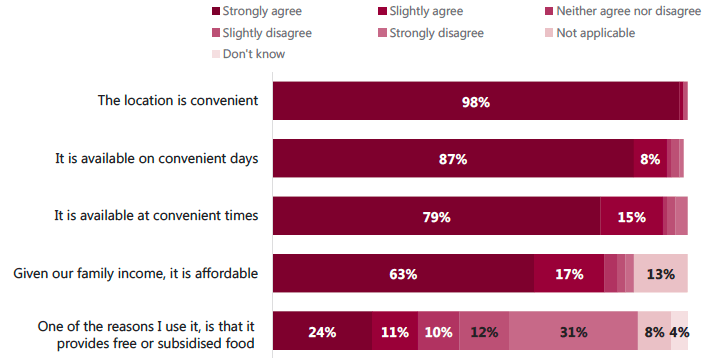
Base: All those who use breakfast clubs (266)
- A third (35%) of parents agreed the provision of free or subsidised food was a reason for using the club, while 43% disagreed and 8% said this did not apply since this was not provided by the club.
- Single parents and those living in the most deprived areas (SIMD 1) were more likely to agree that one of the reasons they used a breakfast club was for free or subsidised food (44% and 53% respectively, compared with 35% overall).
After-school clubs
- Views on the convenience and affordability of after-school clubs were similar to those on breakfast clubs, again more highlighting the importance to users of these factors. Among parents whose child attended an after-school club (23% of those who used term-time care, and 14% of all parents) almost all agreed that the club was available on convenient days (97%), at convenient times (97%) and in a convenient location (95%). A majority also agreed that the club was affordable – 86% agreed, while only 8% disagreed (Figure 3.5).
- In comparison to breakfast clubs, the provision of free or subsidised food was less likely to be a reason for using an after-school club. Only 16% of parents agreed they used an after-school club because it provided free or subsidised food. Half (52%) disagreed with this statement, while 22% said this was not provided by the club.
- As with breakfast clubs, single parents and those living in the most deprived areas (SIMD 1) were more likely to agree that one of the reasons they used an after-school club was for free or subsidised food (34% and 27% respectively, compared with 16% overall). Further, single parents were less likely to agree that their after-school club was affordable (74%, compared with 88% of couples).
Figure 3.5: Views on after-school clubs
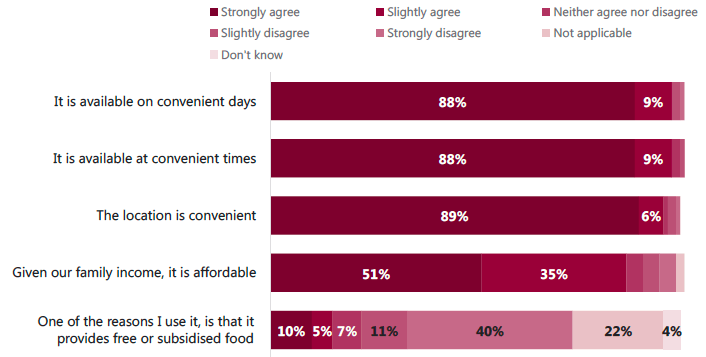
Base: All who use after-school clubs (271)
- Term-time childcare users who did not use breakfast or after-school clubs were asked why they did not use these types of formal care. The main reasons given were because they thought these clubs were too expensive[17] (31%), and because they preferred family or friends look after their child (26%). Other reasons were that it was not possible or convenient to use breakfast or after-school clubs because there were no clubs in their area (15%), that the timings and availability of the clubs did not suit them (11%) and that they found their current arrangements more convenient and/or easier to access (9%) (Figure 3.6).
Figure 3.6: Reasons for not using breakfast or after-school clubs (among users of other types of care)
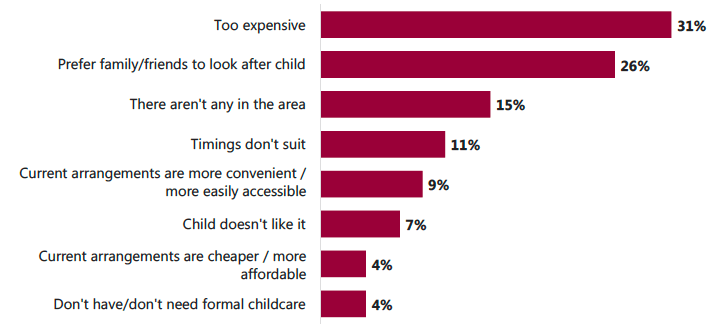
Base: All who use term-time childcare but do not use breakfast or after-school clubs (800) Participants could give more than one response.
- Parents living in remote rural areas[18] were much more likely to say that there were not any breakfast or after-school clubs in their area (66%, compared with15% overall). Those living in areas of mid-level deprivation (SIMD 3) were also more likely to say that there were none of these clubs nearby (23%, compared with 15% overall).
Non-users of term-time childcare
- Around two-fifths (42%) of all participants said they did not use any type of childcare during term-time.
- As noted above, the working status of a family strongly influenced the likelihood of term-time childcare use – 70% of families with at least one non-working parent did not use term-time care. Relatedly, families earning less than £20,000 per annum[19] and those living in the most deprived areas (SIMD1) were less likely to use any type of term-time childcare (58% and 50% respectively did not use term-time childcare, compared with 42% overall).
- Families with three or more children were also less likely to use term-time childcare (54% did not use term-time childcare, compared with40% of families with one or two children).
- As shown in Figure 3.7, the main reason by far that parents did not use term-time childcare was because they felt it was not currently needed, since they/their partner could look after the child themselves (80%). Thirteen per cent said they could not afford formal childcare, while 5% said their child was old enough to look after themselves, and 4% said there was no childcare available nearby. Three per cent of parents said they did not use term-time childcare because their child had a disability or support needs, with some parents further commenting that appropriate childcare support was not available for their child in their local area.
- The availability of nearby childcare was more an issue for those living in remote locations than elsewhere, mentioned by 12% in those areas, compared with 4% overall.
Figure 3.7: Reasons for not using term-time childcare
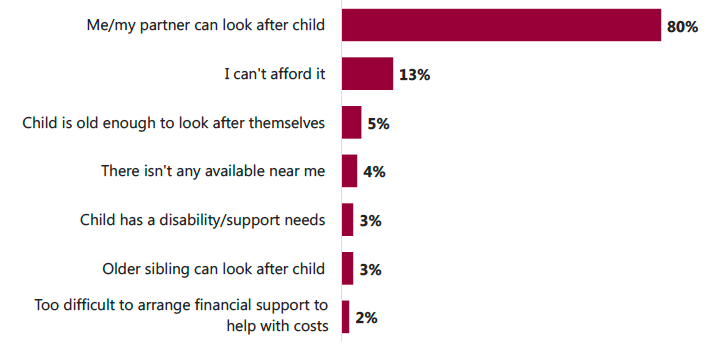
Base: All who do not use term-time childcare (749) Participants could give more than one response.
Accessing breakfast and after-school clubs
- As shown in Figure 3.8, over half of parents who did not use term-time care were aware of affordable breakfast (61%) or after-school clubs (55%) near to them. However, overall 45% and 39% said that there were either no affordable breakfast or after-school clubs nearby (20% and 25% respectively) or that they did not know of any (19% and 20% respectively).
Figure 3.8: Awareness of nearby, affordable breakfast and after-school clubs among those who do not use any term-time care

Base: All who do not use term-time childcare (749)
- Those living in remote rural areas were more likely to say there were no nearby, affordable breakfast clubs (56%, compared with 20% overall), or after-school clubs (43%, compared with 25% overall).
- Those living in areas of deprivation SIMD 3 or 4 were also more likely to say there were no nearby, affordable breakfast clubs in their area (28% and 31% respectively, compared with20% overall), while those with an income of less than £20,000 per annum were more likely to say there were no nearby, affordable after-school clubs in their area (36%, compared with 25% overall).
- Parents who said there were no affordable breakfast or after-school clubs near to them were asked if they would be interested in using these clubs if they were available. Forty four per cent of parents said they would be very/somewhat interested in using an affordable after-school club if it was available, and 31% said they would be very/somewhat interested in an affordable breakfast club (Figure 3.9).
Figure 3.9: Interest in affordable breakfast and after-school clubs

Base: All who do not use term-time childcare who said there were no affordable breakfast or after-school clubs nearby (296;320)
- In each case, parents were most interested in using these clubs for children aged 5 to 7 – 48% said they’d be interested in using a breakfast club for their 5 to 7 year old (compared with 34% for 8 to 10 year olds, and 18% for 11 to 13 year olds), and 62% said they’d be interested in using an after-school club for their 5-7 year old (compared with 47% for 8 to 10 year olds, and 29% for 11 to 13 year olds).
- Single parents and families earning less than £20,000 per annum were also more interested in using after-school clubs (59% and 54% respectively, compared with 44% overall).
- Those interested in breakfast and after-school clubs said the main reasons they would use them would be to allow them/their partner to work (43%), while one in five (19%) said using them would allow them/their partner to work more hours (Figure 3.10)[20]. Around a quarter said they would use the club to give their child the chance to spend time with other children (27%) or do other activities (26%).
Figure 3.10: Reasons parents (who currently do not use any term-time care) would be interested in using affordable breakfast and after-school clubs
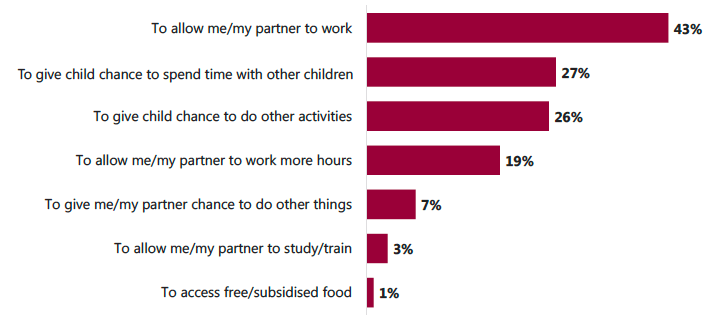
Base: All who do not use term-time childcare, who said no affordable breakfast/after-school clubs nearby, but interested in using them (168) Participants could give more than one response.
Contact
Email: socialresearch@gov.scot
There is a problem
Thanks for your feedback